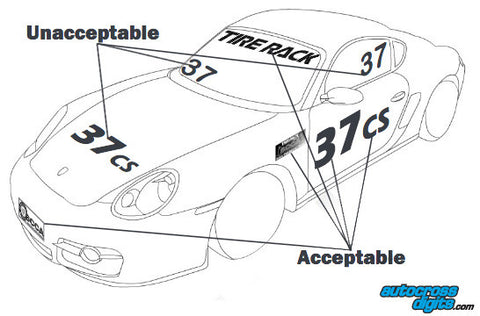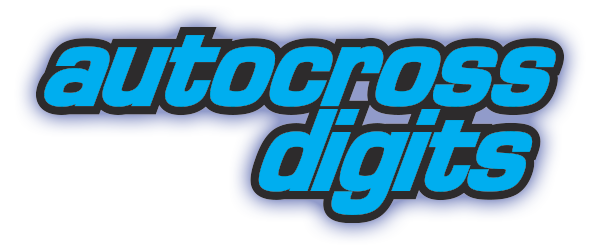Current (2024) SCCA Solo and NASA Autocross Number and Class Marking Rules

So exactly what are the requirements for autocross numbers and class letters? That's a good question, and one to which we can find an answer by referencing the SCCA Solo and NASA Autocross rule books.
SCCA
The 2024 SCCA rule book has not been changed from 2023 to 2024. It states...
3.7 - Vehicle Identification
Both sides. Not the front, rear or top, but sides. Our sets all come as a set - one for each side, at no extra charge.

This one's important. Nowhere on the car should any other class or number markings be visible while on course. We've seen at local events that the codriver's "1" will be stuck on the trunk or roof. Technically, this is not legal. The same goes with the "L" if your car is being run in the ladies class as well.
I can't say we've seen this happen in the past, but it's good of the SCCA to clarify. Additionally, all class letters we produce are upper case, complying with this line.
There are a couple of points to note here. Make sure your class is immediately next (generally to the right) of your number. Especially notable for the blue tape and shoe polish crowd - numbers go on the body panels, not on windows. This is largely due to the fact that windows tend to be a difficult surface with which to contrast, as they are so reflective. Pertaining to that point, numbers must contrast with the panel color. That's why our outlined premium magnetic numbers and outlined premium low tack numbers are a top choice - combined with another number color, the white outline almost certainly offers contrast.
Now we're to the nitty gritty - the sizes. 8" high for numbers and 4" for class letters. That's simple, but the stroke, meaning the thickness of the digits, is also specified at 1 1/4" for numbers and 3/4" for letters. This is simply to ensure markings are visible to workers, as thicker, bolder fonts are more easily readable than thinner fonts.
Ditto for the "1" and "L" on codriven and ladies cars.
1. Numbers must be displayed on the front and rear in addition to both sides.
2. Class letters must be on both sides.
3. In no case may the numbers be smaller than 6” (15.25 cm) in height with ¾” (2 cm) stroke, using a high-contrast color and background.
Karts are given some leeway, but 6" numbers can still be a challenge; especially on an FJC kart. The most important aspect here is to use high contrast colors.
We've got you covered here. Grab some magnetic sheets to affix these decals to your car in a non-permanent manner.
NASA
NASA-X's rules are a bit less wordy, stating that numbers must be 8" on both sides on their tech inspection form.
In conflict though, the NASA TT Rules state something different.
Section 12 - Car Appearance
Theoretically, the NASA TT rules are the rules of record for NASA X, with the NASA X rules being supplemental. So which is correct? In all the NASA events we've attended, the 8" rule looks to stand, and numbers must only be present on the sides of the car - not on the front and rear like the TT rules suggest.
Examples
If you're like us, some visuals go a long way.
Good:



Bad (not enough contrast):

In Conclusion
Most of these rules are common sense. Putting yourself in the shoes of the Timing and Scoring folks will go a long way towards ensuring you make their job easier, and they ensure you get scored correctly.
In conclusion, to be legal for both SCCA and NASA events, the minimum height for numbers is 8", and the minimum height for class designations is 4". At Autocross Digits, we keep this in mind when designing all our sets, so you can rest assured knowing you'll be legal when running our digits.
See you at the races!
